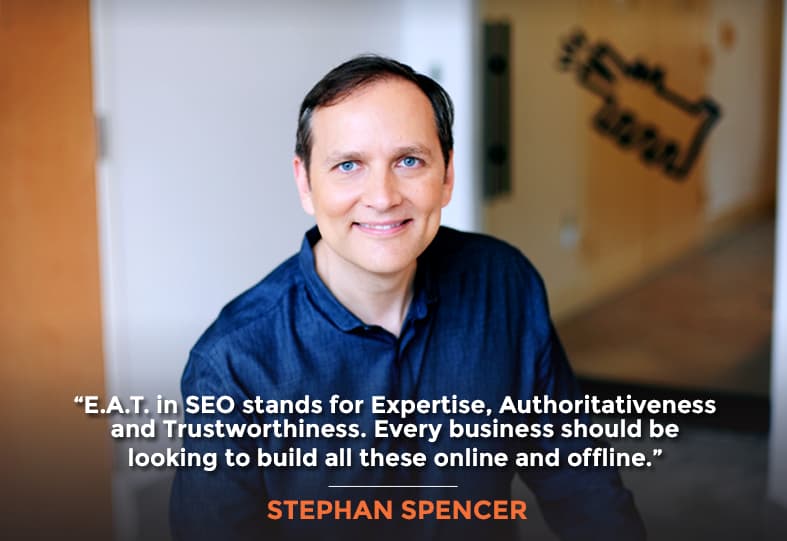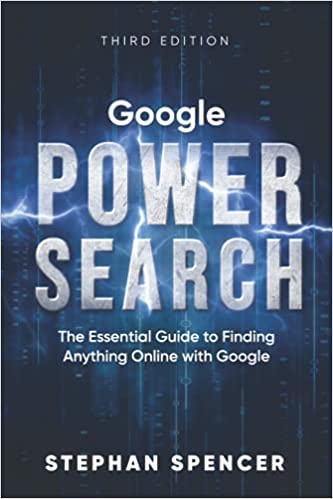If you have a blog, then you must optimize that blog in order for your posts to rank. Of course it all starts with quality content, but that’s not enough. For instance, you must also have authority and trust in the eyes of Google.
Today’s episode is a special one because I’m sharing a BlogHer 2020 conference presentation that I got to do in collaboration with my amazingly talented daughter, Chloe Spencer. This was a luncheon session where we offered bloggers tactical, hands-on tips to demystify SEO and give them leverage over the competitors.
In this session, we talk to bloggers about the biggest SEO mistakes they are making. We also critique some websites from the audience and advise them on some of SEO’s low-hanging fruit they can implement. We get into topics like brand building, the importance of having your own domain, and short URLs versus long ones. We break down Google acronyms like E.A.T. and so much more. I think you’ll find this to be a really fun and informative episode about all things blogging and SEO. So, without any further ado, here’s the presentation!

In This Episode
- [01:49] How do you check if you have tag pages indexed in Google?
- [03:49] Chloe Spencer explains what a title tag is.
- [05:55] What are duplicate contents?
- [10:54] How do we optimize target keywords?
- [13:29] What happens when your category pages are not linked to every page of your site?
- [16:12] Why lead with a number when doing a keyword search?
- [21:55] How SEO works, and how to use it?
- [22:57] What components should your website possess to be ranked in the search engine?
- [25:44] How link building increases the quality of your website?
SS: Here’s what we’ll cover in this 30-minute session: The biggest SEO Mistakes that bloggers make, SEO tips and tricks, and SEO tools. We’ll also try to get some blog critiques in that time slot.
I’ll start with tag pages because tag pages are the devil. Who has tag pages on the blog?
CS: Who knows what tag pages are? When you have a blog, and you’re writing a blog post, and there’s a spot where you can put in text, and it’s putting in all these different keywords, and you don’t know what they’re doing and why those they are going to be tag pages. Pages that are all tagged with that specific keyword. They’re all just going to be on this list. That doesn’t do anything for you.
The main foundational parts of SEO are broken down into on-page SEO, off-page SEO, and technical SEO. Share on XCategory pages, on the other hand, are great for SEO. But, unfortunately, the tag pages are worthless. In fact, you should remove them and never use them again.
SS: To check if you have tag pages indexed in Google, type in site:(your domain name). So you’re going to Google for site:blogger.com or whatever your domain is. Then you’re going to look for tag pages in the results.
If you want to get fancy, you can add that to the search query, inurl: tag, but I don’t want to complicate things overly. So that’s how you’ll see if you have tag pages indexed. Then you’re going to go into your Yoast SEO settings and hit the little checkbox that says to ‘noindex‘ those.
Next, we’ve got date-based archives. I don’t think users are interested in going to, let’s say, “May of 2018.” That’s not that useful.
CS: Yes, it’s not necessary to use those.
SS: It’s not great anchor text for the search engines to associate with the pages you’re linking to. They’re not going to rank, in other words, not well, unless you’re trying to optimize for May 2018. So those are not great—so sucky title tags.
CS: Sucky title tags. Who here knows what a title tag is? The title attribute in the head and HTML, and that’s too geek for you. The snippet of wording is at the top of your browser window. Or if you have multiple tabs open, it’s the title of each tab. That is your title tag for that page; every page has one. You can set this with the Yoast SEO plugin and other ways. But that’s the easiest way to put your title tags.
Title tags are one of the primary spots for your keywords.
Now, title tags are one of the primary spots for your keywords on each page. To be a title, you don’t want to make it long. You want to avoid keyword stuff. It should be a good title, but it should have your primary keywords for that page in your title tag always. At the beginning of your title tag, Googlebot gives more weight to the keywords or the beginning of your title tag versus the end.
There are more best practices on this. Just Google through all of that in this session, or we can jump on a call and pull up your site after the session, and I’ll walk you through it. Your title tag is super important. Your Meta Descriptions are going to be a little different.
Google is not looking at your keywords and your meta descriptions, okay? Meta descriptions are purely for your users. When you google something, and the ten organic results come up with a title tag that you set for your page as a title of that listing in Google, then the meta description leads to show you the description. You want to write your meta description, so they’re compelling. They’re going to generate click-through rates (CTR). You’re writing them for your users, or your title tags are written for users and Googlebot.
SS: That, by the way, is a great trick question to insert into an interview. If you’re trying to hire an SEO, ask them the question. What do meta descriptions do for my rankings? That’s a leading question. The only right answer is that it doesn’t improve your rankings; it’s not a ranking signal. Meta Descriptions aren’t a ranking signal.
Meta Descriptions aren’t a ranking signal.
Next, we got duplicate content. Every time you repeat a blog post with a blurb or the entire post—let’s say on the homepage, you’ve got ten posts, and it’s the first two paragraphs—that’s duplicate content. That will also appear on the category pages you’ve associated with the categories in which you’ve put those blog posts. It also appears in database archives. The same text will also appear on the permalink page for the blog post.
There is a lot of duplicate content just by the nature of having a blog. I recommend using optional excerpts, which is a built-in feature in WordPress. Then you’ll use those optional excerpts on every page except for the permalink blog post. That’s unique content from all the other places where you will feature the blog post.
No intro copy is another mistake. Does anyone know what sticky posts are? It gets the post to the top. If you do this for category pages, that copy will be a great keyword-rich introduction copy. Does anyone do that currently (using someone else’s domain)?
Many people think that keyword density is how many times a keyword is on the page. However, it's not about that; it's about where and what keywords are targeted. - Chloe Spencer Share on XCS: Sure. There’s a difference between wordpress.com and wordpress.org. I found this out the hard way. When I started my blog at 14, it was a wordpress.com blog. It was, I think, neopetsfanatic.wordpress.com or Blogspot or whatever it might be. This is a big mistake. You don’t want to be in someone else’s domain. Have your own. Have your own and have it hosted on a host like HostGator, Bluehost, GoDaddy, whatever, whichever one you want to use, and make sure you have your domain.
SS: Yeah, even medium.com. You want to have your posts live on something other than that domain. You want it live on your site.
Next, we’ve got lousy URLs.

CS: The URLs of all of your pages, you don’t want them to be super long with all these weird words and numbers. Short and sweet. That is the trick. When you’re writing a new page, you can edit the slug. It’s also called the path. It’s just the words that come after your domain. So example.com/ and then that’s what we call the path.
You need to edit that down and ensure that if you’re writing a blog post with a really long title, you cut that down inside the path when you’re writing your blog posts. Just use good keywords. Make it short and sweet.
If you don’t have EAT—you don’t show your credentials, diplomas, or certifications; you don’t have authoritative and trusted links pointing to your site, then Google will treat you accordingly.
If you’re going back and changing those URLs right now, you will say, “okay, I’m going to go look through my blog post.” Yeah, these URLs are terrible. They’re super long. We’ll automatically do a 301 redirect so that it doesn’t render a 404-page error because then it’s like a not found error, and your page doesn’t exist anymore. You don’t want that. So if that were to happen, you should do a 301 redirect. There’s a plugin for that called redirection. You could use that.
SS: But it’s already built into WordPress. Changing the post slug will automatically redirect from the old URL to the new one. So you don’t have to worry about the redirection plugin for changing the post slug.
Then not building up your EAT, which stands for expertise, authoritativeness and trustworthiness. This is an acronym that came out of Google. They were using it to describe the credibility of websites. The human reviewers that they employ to look at websites such as yours determine whether that is a credible source.
If you don’t have EAT—you don’t show your credentials, diplomas, or certifications; you don’t have authoritative links pointing to your site, you don’t have trusted links to your site, and it doesn’t look good—then Google will treat you accordingly, which is not what you want. You need EAT. I have an article in Search Engine Land called There’s no shortcut to authority: Why you need to take E-A-T seriously.
What do we optimize? It’s target keywords.
CS: Yup. I want to back up a little bit. Many people here probably don’t know the pillars or the main foundational parts of SEO. We can break it down into on-page SEO, off-page SEO, and technical SEO.
When we’re looking at on-page, that includes your content, how high quality your content is, and the keywords you’re targeting on your pages.
When we’re looking at on-page, that includes how high quality your content is and the keywords you’re targeting on your pages.
Your off-page is really who’s linking to you, what we call your link profile, your inbound links. That’s the biggest piece of the puzzle here. They all go hand in hand. It’s like a three-legged stool. If one of them isn’t there, then it will fall. So you need all of them. There are all these puzzle pieces, but that’s the most important one.
Then there’s your technical SEO—your page speed, looking at your mobile friendliness, your errors and all that good stuff.
Back to your on-page—the way that you should be targeting keywords. There are so many myths about that won’t die about keyword targeting. Many bloggers think keyword density is the thing they need to pay attention to, how many times your keyword is on your page. It’s not about that. It’s about where and what keywords you’re targeting.
There are only a few spots for your keywords, title tag, H1 heading, and then the first sentence or two of your body copy. Those are the most important spots for your primary keywords. They don’t need to be repeated, as is elsewhere throughout your page. That’s the most important thing when you are targeting.
SS: It’s not about repetition, as Chloe says. You should think about some related keywords. For example, if you’re writing a blog post about lawnmowers, and you never mentioned grass, yards, lawns, weedwackers, landscaping or any of these other keywords, that looks very surface level. Those are called LSI keywords.
We don’t want to have thin content that’s thin because it’s just too short. We don’t want to have thin content that’s just a repetition of the same keyword repeatedly.
They’re related keywords that make your content look deep and not shallow. So we don’t want to have thin content that’s thin because it’s just too short. We don’t want to have thin content that’s just a repetition of the same keyword repeatedly. And we don’t want to have content that is surface level in that it doesn’t go deep into the topic.
Title tags, categories, and URLs. Those are next.
CS: Well, we already went over title tags, URLs, and everything.
SS: Okay, category pages. These are missed opportunities for many blogs because they often target a certain powerful keyword. If they’re not, you should change your categorization. They’re linked to every page of your site.
They’re usually part of your main nav, your top navigation. They’re in your footer. So you want to take advantage of all that internal link equity and use those category pages well.
Remember, one of the things you can do to make those category pages sing to the search engines for the keywords you’re targeting is to have an intro copy using sticky post navigation. That includes related posts and breadcrumbs.
Does anyone use the breadcrumb navigation type of plugin for WordPress? You might want to consider that—just a couple of you—because that reinforces the internal linking structure.
Related post. Does anyone use the YARPP (Yet Another Related Post Plugin) or anything like that? That gives you additional internal links to your important stuff related to the posts the search engine is indexing.
Next, we have the RSS feed. It’s a really simple thing. Suppose you have left that setting, just another WordPress blog. Do you ever see that when you start a new WordPress blog? If you leave that alone because it’s not displayed on your website, guess what? It’s still shown in your RSS feed. That could be the description of your blog on various websites that are pulling data from your RSS feed, so fix that.
Body copy, there’s one other thing I’ll say about that. Try to internally link to other site pages, like the New York Times links to their topic pages from relevant articles in the body copy of the articles. That’s why they rank number four in Google for Iraq because many articles about Iraq link back to the Iraq topic page in the copy. Anything else you want to say about the body copy?
CS: No, that’s pretty great. I want to get through. I don’t want to go too deep into the technical stuff because some of it is geeky.
It's imperative to do keyword research and not just go with your gut because you must figure out the data to determine which keywords you should target. - Chloe Spencer Share on XSS: Yeah, there’s another slide we’ll pass here because it’s pretty technical, robots.txt, XML, Sitemaps, etc. Titles and headlines. Why lead with a number?
CS: Basically, when you’re thinking of titles for your page, so the H1 title of your page or post versus your title tag—those can be different, and they should be different—when we’re talking about lead with a number, like five ways to do whatever, five myths to this, or the ten best blah-blah-blah, these number-based titles do well on Google, so you should take advantage of that. That’s why we want to lead with a number for many of these different pages where that’s applicable.
Hardcore research was done to determine the reader preferences for different types of headlines.
SS: Don’t just take our word for it. Hardcore research was done to find out what reader preferences were for different types of headlines. So, for example, number-based headlines, according to this conductor study, which is written up on moz.com, five reader headlines that users clicked, something like that as the title, that conductor study found that number-based headlines performed the best, like 30-some percent, versus the worst performer, question-based headlines.
If you tend to do question-based headlines, you should rethink that because that percentage was 12% or 18%, something markedly less. When you decouple the title tag from your title, the name of your blog post, or the name of your page, you can incorporate other keywords and cut out a lot of the fluff.
This screenshot here that you see is from my plugin called SEO title tag, which allows you to mass edit title tags across your entire blog, which is pretty cool. You don’t have to go individually to every single blog post one at a time, edit it and then save it. Instead, go to the next one and then edit and save it. This lets you see a whole bunch of title tags in one go. You can even mass edit the post slugs as well.
Next are some essential tools. Again, these are some of our favorites. Soovle, AnswerThePublic, and Moz.
CS: It’s imperative that you do keyword research and not just go with your gut because you have to figure out the data to determine which keywords you should target. There are keyword brainstorming tools like Soovle and AnswerThePublic. These are awesome tools, but they’re not going to give us search volume data, which is what we want to do after doing our keyword brainstorming.
Moz Keyword Explorer is fantastic for keyword research. You can see how many searches these keywords get in Google monthly.
Something like Moz Keyword Explorer is fantastic for keyword research and see how many searches these keywords get in Google monthly. You can choose which country, and for the most part, you do the United States, and then you can discover different keyword opportunities. You can look at all these related keywords or include the words you put in your query or don’t include.
It’s awesome. This is a paid tool, but it’s so worth it. If you have a group of blogger friends, have everyone go in on it, and you can all share it. You can create keyword lists. It’s awesome, so absolutely use a tool like Moz Keyword Explorer.
Don’t use the Google Adwords Keyword Planner, though, because that’s a highly inaccurate tool. The reason for that is that they group their keywords by buckets. Sometimes it’ll be 3000–40,000 searches off. If the keyword falls somewhere in the middle, it will be lumped into one bucket. It’s giving you inaccurate search data, so don’t use that tool. You can also use Ahrefs, which is another great tool. Then what was the other tool?
SS: Semrush. Let’s see what these tools look like. This is Soovle. As I type some keystrokes, it’s auto-completing, not just from Google but also from Bing, Yahoo, Answers.com, YouTube, Wikipedia, and Amazon, all simultaneously.
As I keep typing, I can click on any of these, and it will take me directly to the search results for the keyword I clicked on in that search engine. That’s a great way to get keyword ideas when you’re brainstorming.

But when you get to that hardcore research phase, where you want to see the differences in the numbers of searches for each keyword, that’s where Moz Keyword Explorer comes in. So that’s what Chloe is explaining.
We could put in (let’s say) SEO here and then choose the US or whatever region we’re trying to target. It will tell us more than just the search volume number of searches estimated per month. It’s a range, but it’s 95% accurate because of how they do it. It’s really great.
They also give you difficulty scores, which is cool. You can see how hard it is to break into page one for that keyword. And then AnswerThePublic.
AnswerThePublic is another great keyword brainstorming tool.
CS: AnswerThePublic is another great keyword brainstorming tool.
SS: Do you want to explain how this works? I put an SEO.
CS: Go ahead and explain it.
SS: Okay. I’m going to zoom in. They’re what, where, when, why, and how types of search queries that are popular and are recommended by Google Suggest. This tool scrapes all those and then puts them in a nice pretty wheel.
See the different kinds of keywords. These searches are questions like who, what, why, when and why. In this case, we’re looking at implied questions like is or can. That is a question too near that sort of thing.
Here’s our “how SEO works, how SEO is done, how SEO increases sales.” You might create blog posts about these different topics thinking, “wow, this is stuff that people are searching for on my topic.” Let’s make an FAQ. Let’s create blog posts. Let’s build out a learning center based on this stuff.
Then we have Majestic. Do you want to mention Majestic?
Google looks at your site authority when determining where to rank you in their search engine.
CS: Sure. When we were talking about off-page SEO and your link profile—who’s linking to you—and being such a foundational, huge part of SEO, we can look at that by looking at your site authority. This is what Google looks at when determining where to rank you in their search engine.
You’re much more likely to be ranked in the search engine if you have an authoritative, trusted website. If not, then you’re not going to rank at all. Even if you do, everything is all this good on-page stuff. You’ve done all your keyword research, blog posts, and everything, but your site has zero authority, you won’t rank. So you must build authoritative links and up your site’s authority.
If you’re thinking, “Okay, well, what’s my site’s authority?” We can use third-party tools to take a look at this. Majestic.com is one of the best ways to examine your site’s authority. This is a paid tool, but you also get a few free daily searches. Again, you could go in on it with some blogger friends. You can all use the tool in more depth. You can look into your backlinks.
I highly recommend it. Later after the session, look up your domain on majestic.com and see what your authority is. This score is from 0 to 100. It’s on a logarithmic scale, like the Richter scale. Even if you see it’s 10; it’s not 10%. It’s going to be lower. Increasing your score once you reach a certain point is hard. You’re not ever going to reach 100. Even Bed Bath & Beyond is 60 or something like that. If you’re at a 30, that’s a great score to be at. You want to go higher, but 20–30 is a starting point.

SS: I got a 48.
CS: Well, you know it takes a long time.
SS: I worked hard for many, many years. Who’s Thai Caliente? Your trust flow score is nine, so that’s not great. Your citation flow is important; also, on a log scale is a 21. So you’re more important than you are trusted. You want to be the opposite. You want to be more trusted than you are important.
Link building is all about quality over quantity. It's not about how many sites are linking to; it's about how high quality those sites are. - Chloe Spencer Share on XThink of somebody while you get more trusted links. For example, I spoke at Stanford for free and paid for it on my own dime to fly out there because I got a link. I wasn’t going to get one for sure. But I did a great job, and they linked to six different resources I mentioned in my talk. So Stanford.edu is a super high-trust website. Totally worth it.
CS: Link building is all about quality over quantity. It’s not about how many sites are linking to; it’s about how high quality those sites are. One really powerful authoritative link will trump a thousand low-quality links. It’s all about quality.
SS: Do you want to mention PageSpeed Insights, and I’ll pull up the tool while you talk about it?
Google will look at how fast or slow your pages load. So it’s important that you have a fast-loading site.
CS: Sure. I talked about page speed when we’re talking about your technical SEO. This is how fast your site loads; you will have a different page speed on desktop and mobile. You can look at this through PageSpeed Insights, a free tool provided by Google. You can see how fast your page loads.
If you have a low score, you need to get a developer to help you increase that because this is a ranking signal. Also, Google will look at how fast or slow your pages load. So it’s important that you have a fast-loading site. If you don’t, do increase that.
Increasing it gets technical. Get a developer to help you. You don’t want to mess with that yourself. It’s important that you look at these things and know that they need to be fixed. This is slowing me down. This negatively impacts my ranking, so I will oversee this and make sure it gets fixed.
SS: All right, who’s Uninvisible Pod? We’re just pulling up PageSpeed Insights, which is a free tool. Having enough traffic to your site will give you data from the Chrome user experience report, real Chrome users visiting your site, and how fast or slow their experience is.
That’s awesome if you have enough traffic to get that data. If you don’t, it will just tell you that there’s not enough data for field data, as is the case with Uninvisible Pod. But then you see the score is based on lab data, on them running some analyses. It’s a 5 out of 100, so I need to work on this.

CS: All right, we’re out of the time, you guys. There was so much that we didn’t get to cover today. But there’s so much more to this, and I want to help you guys as much as possible. So I encourage you to come up, give me your business card, or head to chloespencer.com, and opt for a free SEO strategy session with me.
We’ll get on a screen-sharing call. I’ll pull up your website. We’ll go through some tips and tricks and what’s impacting you not getting the traffic and rankings you want. So I encourage you to sign up for that or come up to talk to me and give me your business card, and we’ll jump on a call.
SS: That is a great offer. Very generous. I wish I had the time to go over your sites with every single one of you. But you recall that you can get a free copy of my book, Google Power Search, by texting 33444 with the keyword BlogHerSEO, all one word. Please do that.
I’m also going to include all of you access for 30 days to Module 4 of my DIY (Do It Yourself) SEO auditing course. Module 4 is technical glitches and easy fixes. It’s an expensive course; you get free access to that module for 30 days, so you should take advantage of it. Thank you so much.
CS: Thank you.
Important Links
Connect with Chloe Spencer
Apps and Tools
Book
Businesses/Organizations
YouTube Videos
Your Checklist of Actions to Take
- Discover why my rankings are so low by taking Stephan’s free SEO quiz. Take advantage of Stephan’s free consultation to discern how I can fix my site errors.
- Use keyword brainstorming tools to attain necessary data and build my portfolio. Utilize the keyword tools for comparison purposes. Here are some great keyword brainstorming tools: Soovle, Ubersuggest, Google Trends, and AnswerThePublic.
- Create my website in my own domain. A personalized domain makes my website look professional and more memorable. It also builds my brand and helps visitors find me online. Here are web hosting providers: HostGator, Bluehost, GoDaddy, etc.
- Create and share remarkable content. A noteworthy publication keeps the audience/readers engaged and compels them to like and share content with their friends.
- Write excellent titles for my articles. A good title tag should have my primary keyword and shouldn’t go too long. Remember Googlebot gives more weight to the keywords at the beginning of my title tag than at the end of the tag.
- Write compelling meta descriptions. Meta description does not affect my ranking, however, the meta description generates the click-through rate (CTR ) for my content.
- Network my remarkable content. Reach out to influential websites and blogs to spread my content. Use tools like Majestic, linkresearchtools.com, or Ahrefs to identify the authority and trust of these websites.
- Focus on improving the quality and quantity of my links. Treat these links as PR for my business. The more links point to my site, the more Google deems my website or business worthy of a high ranking.
- Use hardcore SEO tools for real data and don’t base SEO practices on mere suggestions. Some great SEO tools are Google Keyword Planner, Moz, Rank Ranger, and SEMrush.
- Use the SEO BS Detector worksheet when hiring an SEO for my business. The SEO BS Detector has trick questions that I can use in the interview process.
- Check out and read chapter 7 of The Art of SEO. This chapter teaches the fundamentals of SEO.







Leave a Reply